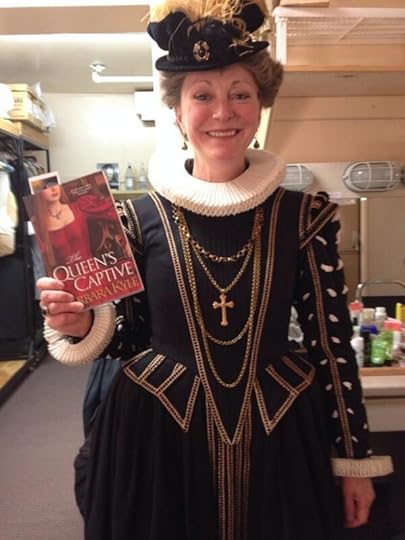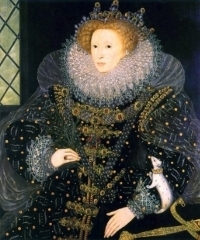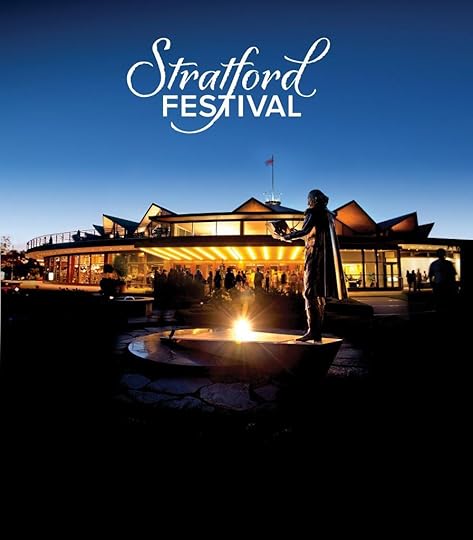Barbara Kyle's Blog: The Rest of the Story - Posts Tagged "shakespeare"
Shakespeare, Bloody Mary, and the Bones of Henry VIII
 Research is the lifeblood of our art. Ask any historical novelist and they'll tell you that poring over the letters of our subjects and reading biographies of them and books about their times is a hugely engrossing part of our work. So engrossing, in fact, that I don't think of it anymore as research but The Search.
Research is the lifeblood of our art. Ask any historical novelist and they'll tell you that poring over the letters of our subjects and reading biographies of them and books about their times is a hugely engrossing part of our work. So engrossing, in fact, that I don't think of it anymore as research but The Search.It's like panning for gold. I sit by the riverside day after day sifting through mounds of information sand - solid facts that I need to ground my stories in the truth of the period, but not exactly eye-opening. It's the nuggets I look for. The details that gleam. Facets that will spark my subject to flesh-and-blood life.
Here are a few such nuggets that I alchemized into the life of my books.
 The Queen's Lady features Honor Larke, the (fictional) ward of (the real) Sir Thomas More. More was Henry VIII's chancellor who famously went to the execution block rather than swear the oath that Henry was supreme head of the church in England, a title Henry created so he could divorce Catherine of Aragon and marry Anne Boleyn.
The Queen's Lady features Honor Larke, the (fictional) ward of (the real) Sir Thomas More. More was Henry VIII's chancellor who famously went to the execution block rather than swear the oath that Henry was supreme head of the church in England, a title Henry created so he could divorce Catherine of Aragon and marry Anne Boleyn. My research revealed that in 1517 More was under-sheriff of London, and that on May 1st of that year - "May Day" - the London apprentices rioted and More went with a troop of guards to meet with them. The young men, their torches flaring in the night, were a furious mob, denouncing foreigners for taking their jobs (sound familiar?). They'd gone on a rampage, breaking into foreign-owned shops and assaulting Italians and Flemings in the streets.
The Nugget. Gleaming at me in my research was the fact that, years after More's death, Shakespeare had a hand, along with a couple of other authors, in writing a play called "Sir Thomas More" and in it is a scene of the May Day riot in which More, as undersheriff, addresses the furious apprentices. I went to the British Museum and read the folio. It gave me goose bumps. Shakespeare's brilliance in writing characters glitters in every line he wrote.
More shames the angry young men by asking how would they feel if they were friendless in a faraway county where they would be the foreigners. Would they not hope to be treated with compassion?
For other ruffians, as their fancies wrought,
With self same hand, self reasons, and self right,
Would shark on you, and men like ravenous fishes
Would feed on one another.
He points out an apprentice whose kind Italian master, a foreigner, is giving him a good livelihood and a secure future. With this tolerant rationale More calms the mob. The event is so stirring I used it, reworked to incorporate my created characters, as the opening of The Queen's Lady.
Nugget #2. Sir Thomas More had two young wards, and my research revealed the eye-opening situation of the Tudor Court of Wards. All orphans, male and female, with significant property became wards of the monarch who then sold the wardships to gentlemen who bid for these prizes. Why? Because the guardian got to pocket the rents and revenues of the ward's lands until the ward came of age, at which time the guardian often married the ward to one of his own children, keeping the wealth in the family. I couldn't resist. I created another ward for Sir Thomas More, Honor Larke, to be my novel's heroine. (Read about how the Tudors exploited wardships: https://www.goodreads.com/author_blog....)
 The King's Daughter, features Isabel Thornleigh who joins the uprising led by Sir Thomas Wyatt, a true event in which the rebels sought to unseat Mary I from the throne in the winter of 1554. The only surviving child of Henry VIII and his pious first wife, Catherine of Aragon, Mary was ruled by religious zeal. As queen she oversaw the burning of hundreds of men and women, earning the name her subjects gave her in her lifetime: “Bloody Mary.”
The King's Daughter, features Isabel Thornleigh who joins the uprising led by Sir Thomas Wyatt, a true event in which the rebels sought to unseat Mary I from the throne in the winter of 1554. The only surviving child of Henry VIII and his pious first wife, Catherine of Aragon, Mary was ruled by religious zeal. As queen she oversaw the burning of hundreds of men and women, earning the name her subjects gave her in her lifetime: “Bloody Mary.” Mary was very close to her mother, Catherine, and badly treated by her father. He treated Catherine even worse, sending her off to a damp, drafty house in the fens of Norfolk, far from the royal court where he installed Anne Boleyn as his new queen. Henry forbade Mary to even see the mother she adored. Mary always believed that Catherine died of a broken heart, and she never forgave her father for it.
The Nugget. I read J.J. Scarisbrick's monumental biography, Henry VIII in which he reports that, for decades after Mary’s reign, there was “whispering” that she had dug up the entombed remains of her royal father and burned him as a heretic. Again, I got goose bumps. I can use that, I thought. And I did. The King's Daughter opens on a snowy night at Windsor Castle where, inside St. George’s Chapel, Mary orders the gravedigger to smash the tomb with his pickaxe. And then she burns her hated father's bones.
 The Queen's Captive opens with the true, harrowing moment when Queen Mary has her half-sister, Princess Elizabeth, arrested and sent as a prisoner to the Tower. Mary had caught the rebellion plotters, including Sir Thomas Wyatt, and had begun to execute them. Elizabeth believed she would be the next to be executed. She was twenty years old.
The Queen's Captive opens with the true, harrowing moment when Queen Mary has her half-sister, Princess Elizabeth, arrested and sent as a prisoner to the Tower. Mary had caught the rebellion plotters, including Sir Thomas Wyatt, and had begun to execute them. Elizabeth believed she would be the next to be executed. She was twenty years old. But Elizabeth survived, and at Mary's death four years later she came to the throne. By any measure, Elizabeth's legendary forty-three-year reign was a magnificent success, whereas Mary's five years as queen had been a disaster. She unleashed religious strife, plunged her realm into bankruptcy to finance the wars of her husband, Philip of Spain, and forfeited Calais, England's last precious toehold in Europe.
Yet it is hard not to pity the woman when we consider what she suffered. She adored her husband, who spent only enough time with her to perform his conjugal duty before returning to Spain. A few months later Mary joyfully announced she was pregnant, good news for her people who were anxious to one day have a king. Mary happily passed the next months employing her gentlewomen to sew baby clothes, installing midwives, and sending ecstatic notices to every head of state about the imminent birth.
The nugget. This is a sad one. Mary's time came to deliver . . . and passed. There was no baby. Hers was a phantom pregnancy. Court gossip raged as she remained holed up in her private rooms, and foreign ambassadors wrote home about the situation with increasing astonishment as Mary willed herself to believe she really was pregnant right through the tenth month. (Some modern scholars have attributed her malady to uterine cancer.) This event became a pivotal one in my novel.
Mary's humiliation over her phantom pregnancy coupled with the desertion of her husband broke her in body and spirit. She died with no heir of her body, an abject failure in her own eyes as a wife and as a queen, for she knew that Elizabeth, whom she considered illegitimate, would succeed her. Mary's life was tragic.
 The Queen's Gamble is set in the first year of Elizabeth's reign when her future triumphs were still undreamed of. Quite the contrary: she was just twenty-four and without allies, since all of Catholic Europe considered her a bastard and a heretic. She and her divided council feared that France would invade via Scotland, a country France controlled. People throughout Europe were laying bets that Elizabeth's reign would not last the year.
The Queen's Gamble is set in the first year of Elizabeth's reign when her future triumphs were still undreamed of. Quite the contrary: she was just twenty-four and without allies, since all of Catholic Europe considered her a bastard and a heretic. She and her divided council feared that France would invade via Scotland, a country France controlled. People throughout Europe were laying bets that Elizabeth's reign would not last the year. In my novel Isabel Thornleigh returns from the New World to find French troops posted on the English border, ostensibly to crush Scottish rebels who have banded together under the firebrand preacher John Knox to oust the French. But everyone believes that once the French defeat Knox they will then invade England.
The Nugget. I read in my research that Elizabeth, though desperate for Knox's rebels to win, did not dare openly send them aid for fear it would provoke the very attack from France that she was trying to prevent. So she sent the gold secretly, via a gentleman of her court. It was stolen en route, and Knox had to struggle on with his campaign until Elizabeth eventually sent troops to help him.
But all fiction springs from a "What if?" question in the author's mind, and I took that glinting nugget of the stolen gold and polished it. It became the driving plot element in my novel: Isabel goes north to Scotland with the Queen's gold while war brews all around her.
 Two more books follow in the Thornleigh Saga: Blood Between Queens features Elizabeth I and Mary, Queen of Scots, royal cousins locked in a deadly rivalry for the English crown.
Two more books follow in the Thornleigh Saga: Blood Between Queens features Elizabeth I and Mary, Queen of Scots, royal cousins locked in a deadly rivalry for the English crown.The latest is The Queen's Exiles which will be released 27 May 2014.

The Thornleigh Saga follows a middle-class English family's rise through three turbulent Tudor reigns. For more information about the books please visit http://www.barbarakyle.com/
*****
Shakespeare, Elizabeth I, and My Friend Brigit

My friend and fine actor, Brigit Wilson, tweeted this photo of herself in her dressing room at Ontario's world-renowned Stratford Festival where she plays Lady Faulconbridge in Shakespeare's "King John."
What good taste she has in books!
Here she is with my novel The Queen's Captive.

I love the juxtaposition of her Elizabethan costume with The Queen's Captive because the book begins with twenty-year-old Princess Elizabeth on her way to the Tower, arrested by her half-sister, Queen Mary. Terrified, Elizabeth was sure she was going to her execution. It was March, 1554.
Two months later, reluctantly bowing to the people's love of Elizabeth, Mary released her, but she kept her under house arrest at the moldy old "palace" of Woodstock for almost a year.
In 1558 Mary died, childless after a failed and unhappy reign, having been virtually abandoned by her husband, Philip II of Spain. Elizabeth ascended the throne at age twenty-five. She ruled for forty-three years, one of England's wiliest and most successful monarchs.
My friend Brigit is also in rehearsals for the Stratford Festival's production of "Christina, the Girl King" in which she plays Duchess Erika Brahe. If you love great theater, check out the Festival's stunning season: http://www.stratfordfestival.ca/BoxOf...
For more about my books, please visit my website: http://www.barbarakyle.com/



